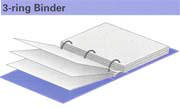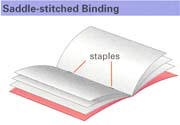

Simple Binding Solutions for Digital Print Jobs
 Comb
Binding:
A plastic insert wraps through rectangular holes punched in the
paper. The lightweight insert can be opened for removal or addition
of pages. Pages can lay flat. Inexpensive and quick, comb binding is
ideal for review documents. The insert generally limits document
thickness to two inches.
Comb
Binding:
A plastic insert wraps through rectangular holes punched in the
paper. The lightweight insert can be opened for removal or addition
of pages. Pages can lay flat. Inexpensive and quick, comb binding is
ideal for review documents. The insert generally limits document
thickness to two inches.
 Spiral
binding,
which can use a thin plastic or wire spiral, provides an attractive,
lightweight document. Pages lay flat, but cannot be removed. Spiral
binding is ideal for teaching materials or user guides. Document
thickness is limited to about one inch.
Spiral
binding,
which can use a thin plastic or wire spiral, provides an attractive,
lightweight document. Pages lay flat, but cannot be removed. Spiral
binding is ideal for teaching materials or user guides. Document
thickness is limited to about one inch.
 Wir-O
binding
provides a sturdier alternative to simple spiral binding, but
produces a heavier document. Use Wir-O binding when you need
documents to lay flat and must ensure that they stay together during
shipping or frequent handling. Document thickness is limited to
about one inch.
Wir-O
binding
provides a sturdier alternative to simple spiral binding, but
produces a heavier document. Use Wir-O binding when you need
documents to lay flat and must ensure that they stay together during
shipping or frequent handling. Document thickness is limited to
about one inch.
 Velo
binding:
Hard plastic 1/8" strips are held tightly together by plastic pins,
which are bonded to the strips by heat. Pages cannot lay flat, and
the tight binding requires that you provide an inch of space on
either side of the gutter. Document thickness is limited to two
inches, and binding may take up to two days.
Velo
binding:
Hard plastic 1/8" strips are held tightly together by plastic pins,
which are bonded to the strips by heat. Pages cannot lay flat, and
the tight binding requires that you provide an inch of space on
either side of the gutter. Document thickness is limited to two
inches, and binding may take up to two days.
 Fastback
Binding:
A cloth or paper strip is wrapped around the spine and glued. Quick,
attractive, and durable, this is an inexpensive alternative to
perfect binding, and is suitable for many types of documents.
Binding strips come in a variety of colors. Pages cannot lay flat.
The maximum number of pages is 120, the minimum, 15.
Fastback
Binding:
A cloth or paper strip is wrapped around the spine and glued. Quick,
attractive, and durable, this is an inexpensive alternative to
perfect binding, and is suitable for many types of documents.
Binding strips come in a variety of colors. Pages cannot lay flat.
The maximum number of pages is 120, the minimum, 15.
 Three
Ring Binder:
The three-ring binder is ideal for many digitally printed documents,
such as user guides, that require frequent updates or additions of
new material. Tab and divider pages, and cover and spine inserts can
also be printed digitally. Because the binder must be assembled
manually, allow for extra time on larger documents.
Three
Ring Binder:
The three-ring binder is ideal for many digitally printed documents,
such as user guides, that require frequent updates or additions of
new material. Tab and divider pages, and cover and spine inserts can
also be printed digitally. Because the binder must be assembled
manually, allow for extra time on larger documents.
 Saddle-Stiched
Binding:
Two or more staples, hidden in the spine, anchor the page folds.
Pages must be imposed on spreads so that they appear in the correct
order when bound, but four-page spreads can save time on presses
that automatically print both sides of the paper. Simple and
inexpensive, saddle-stitched binding provides a professional look
that is widely used on pamphlets, newsletters, and smaller
brochures, such as the one you are reading now.
Saddle-Stiched
Binding:
Two or more staples, hidden in the spine, anchor the page folds.
Pages must be imposed on spreads so that they appear in the correct
order when bound, but four-page spreads can save time on presses
that automatically print both sides of the paper. Simple and
inexpensive, saddle-stitched binding provides a professional look
that is widely used on pamphlets, newsletters, and smaller
brochures, such as the one you are reading now.
(From “An Introduction to Digital Color Printing” by Agfa Educational Publishing. Out of print)

![]() Electronic
Publishing
Home Page
Electronic
Publishing
Home Page
Department of Communication, Seton Hall University